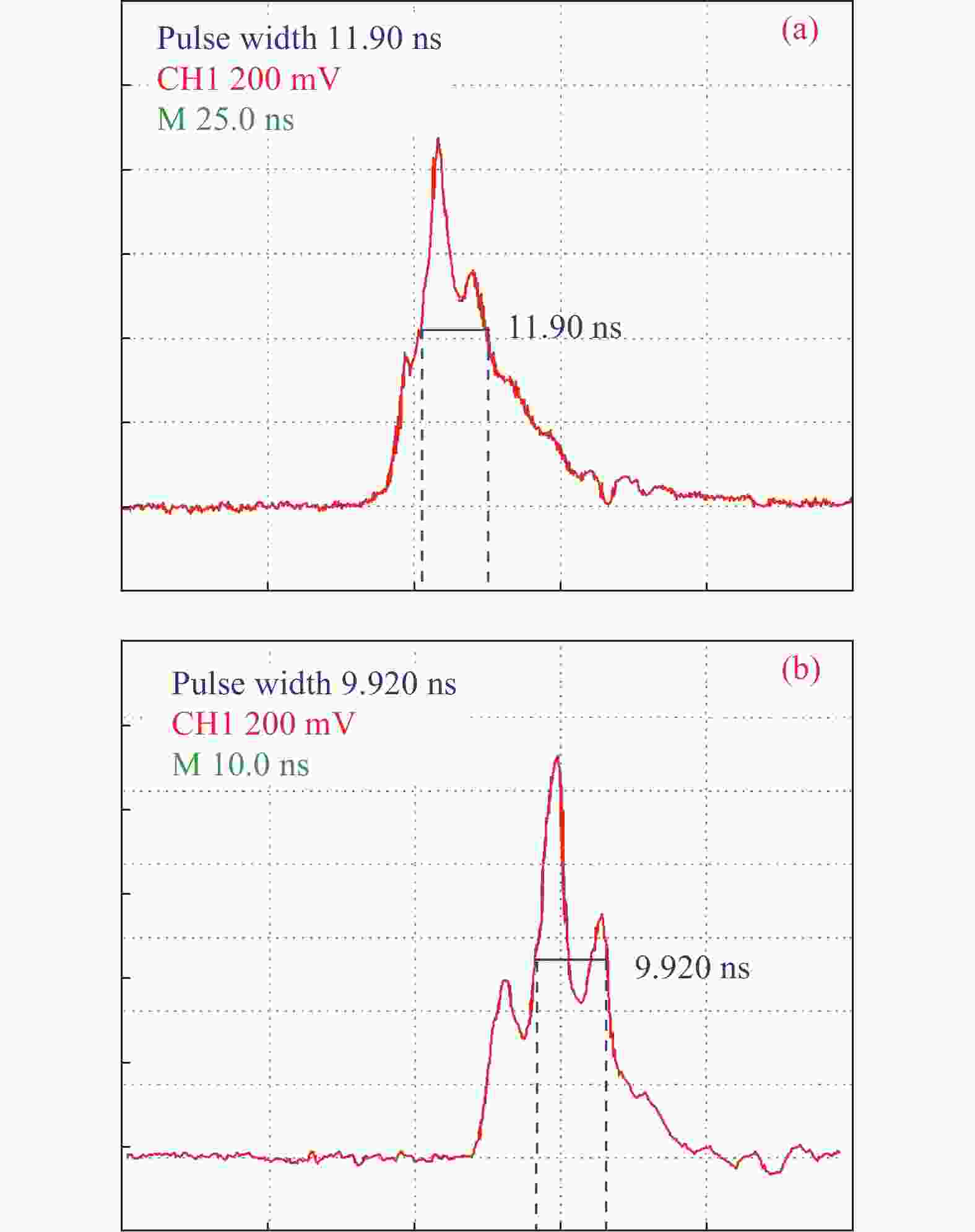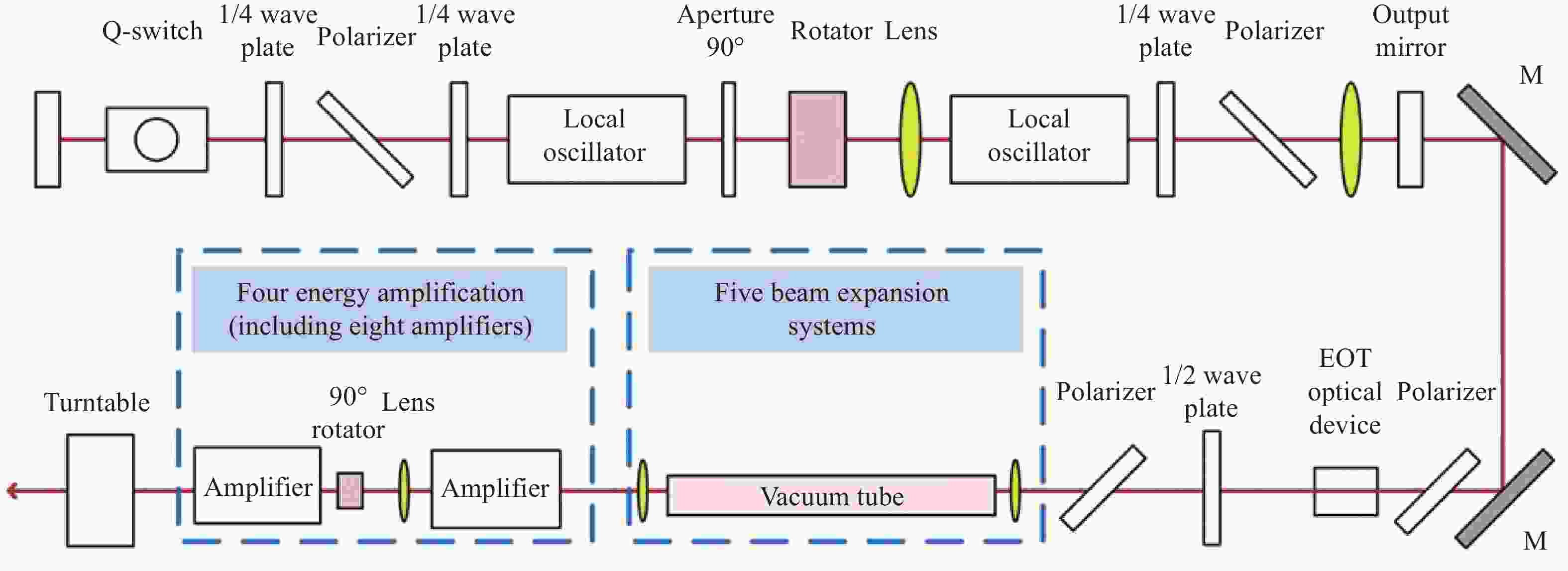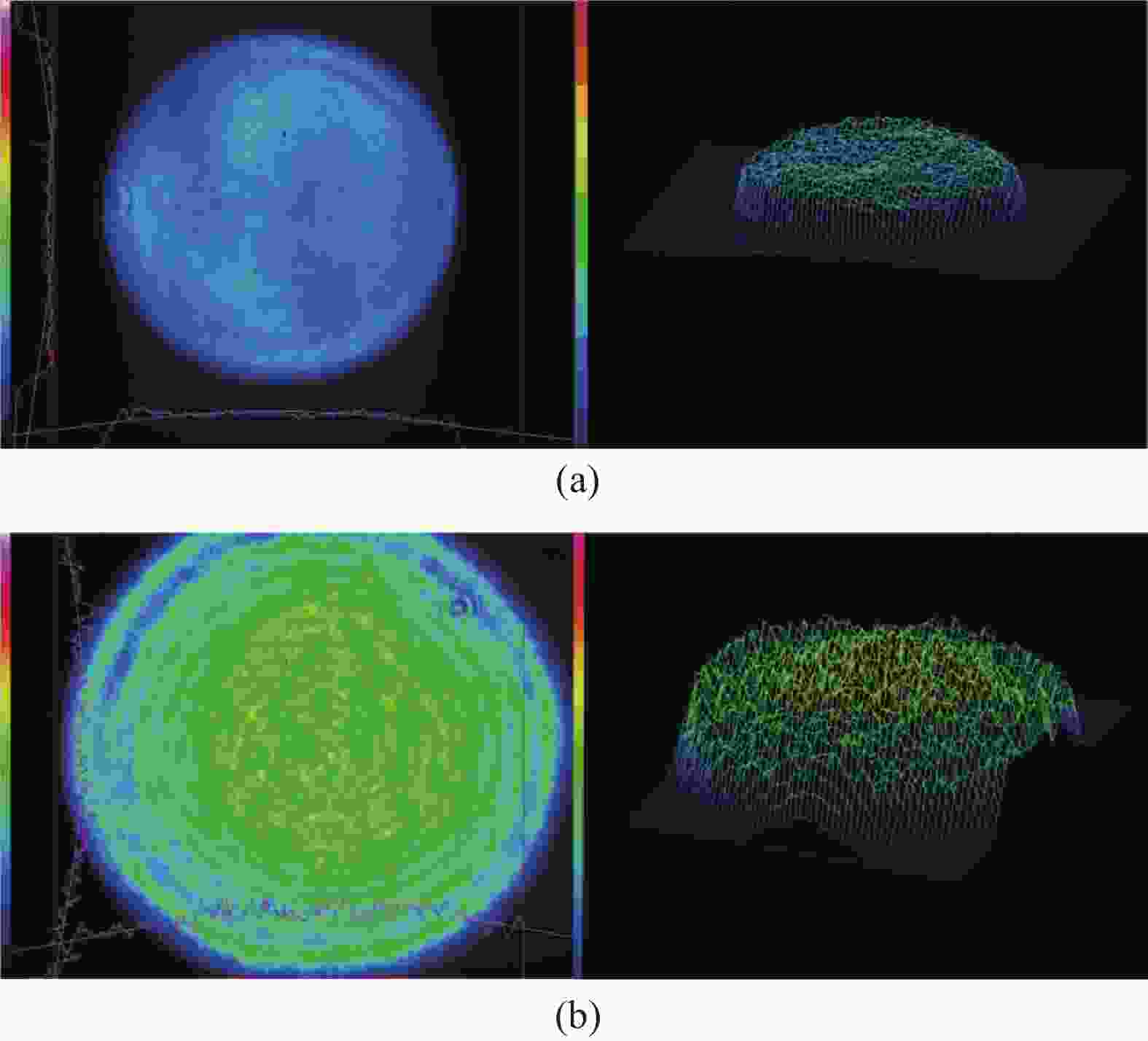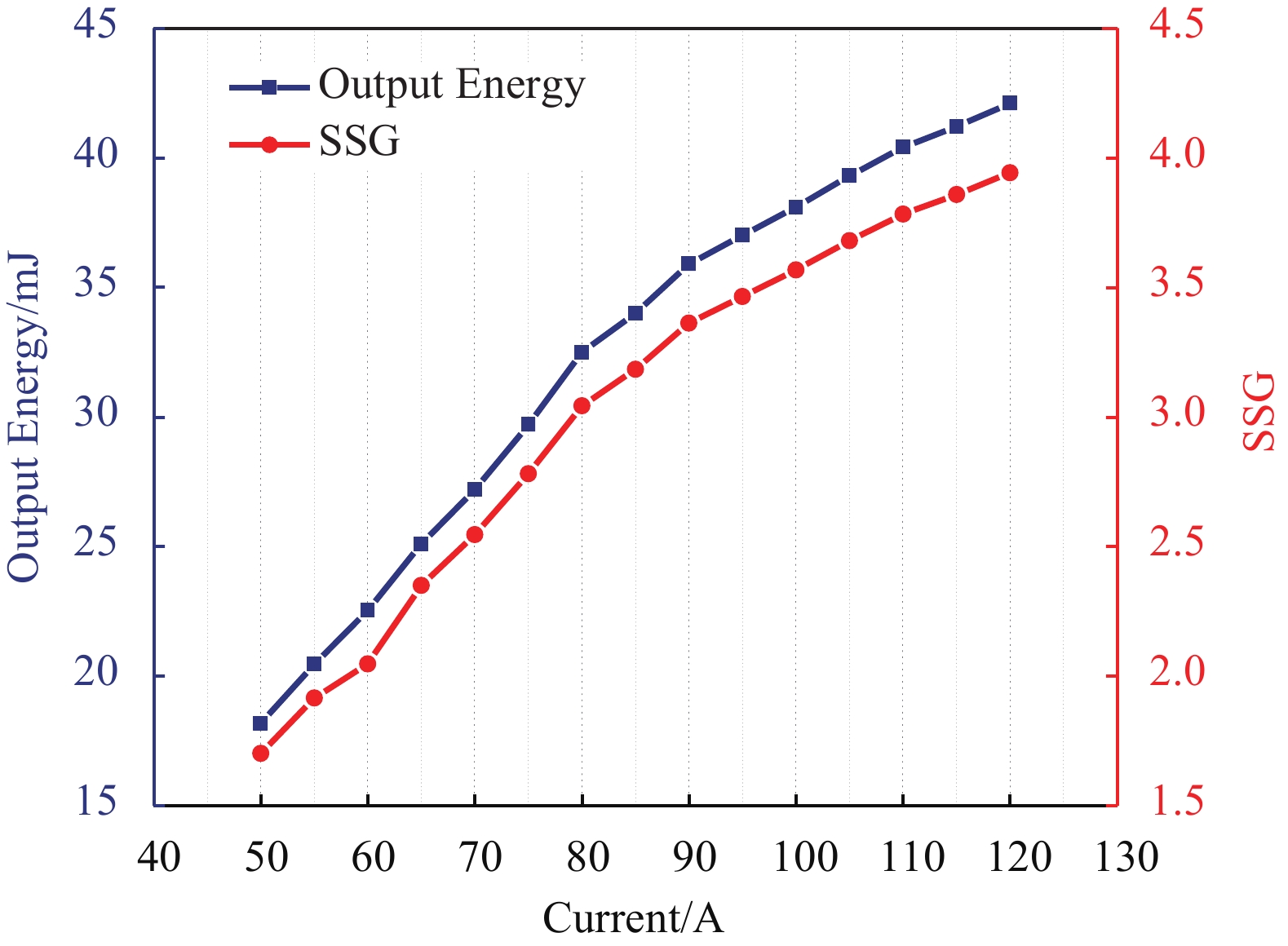-
高能量固体激光器在医疗、工业和科研等领域有非常广泛的应用,并引起人们的广泛关注。激光是一种平面电磁波,由于其有良好的单色性,可以与运动的等离子体内电子相互作用产生辐射,笔者通过分析辐射光谱的强度和分布,可以得到等离子体电子密度和温度[1-2]。激光器作为汤姆逊散射(TS)诊断系统测量等离子体电子温度的光源,在许多核聚变托卡马克装置上都有应用。在英国的MAST装置上,采用了8个频率30 Hz、能量1.6 J的Nd: YAG激光器,合束得到240 Hz的采样频率,实现等离子体电子温度高时间分辨率测量[3]。在欧洲联合环面聚变实验时,JET装置LIDAR TS诊断系统采用3 J的红宝石激光器,实现了对边界区域等离子体电子温度和密度的测量[4]。
在EAST TS诊断系统中,激光器作为该系统的光源,其输出激光脉冲能量和频率直接影响了测量的等离子体电子温度和密度的准确性和时间分辨率[5-6]。目前EAST装置的两个TS诊断系统,分别采用3 J@50 Hz和2.7 J@10 Hz的Nd: YAG激光器,对的芯部区域和边界区域等离子体电子温度和密度进行测量。由于测量EAST芯部区域和边界区域等离子体电子温度的光路长度较长,分别为35 m和43 m,且散射谱的强度与入射激光能量成正比,为保证激光测量数据的准确性,需采用高能量激光器。激光器频率的提高有助于更加精细地研究EAST边界及芯部不稳定性爆发时的温度密度演化过程,设计一台高能高频激光器至关重要。
在EAST TS诊断系统中,用于诊断芯部区域和边界区域等离子体电子温度的探测器灵敏区分别位于近红外和可见波段,因此分别选用可输出近红外和可见波段激光脉冲的激光光源。文中主要设计一台可输出1064 nm和532 nm双波长的高能高频激光器,分别用于芯部区域和边界区域等离子体电子温度和密度诊断。采用Nd: YAG晶体作为增益介质,其硬度高,热导率高,阈值低且增益高,更适用于高能高频激光器[7]。在EAST TS诊断系统测量芯部区域等离子体电子温度时,采用输出波长为1064 nm,输出频率100 Hz的Nd: YAG激光器。以输出基频光的Nd: YAG激光器作为基础光源,通过脉冲能量放大和倍频,输出高能高频的532 nm激光脉冲,用于EAST TS诊断系统对边界区域等离子体电子温度的诊断。
-
基频1064 nm激光器的光路图如图1所示。激光器本振级主要由激光聚光腔、氙灯和Nd: YAG晶体棒组成。采用掺杂Nd+粒子浓度为1%,尺寸为Φ6×130 mm的Nd: YAG晶体作为激光增益介质,晶体前后端面均镀有1064 nm增透膜。通过两级氙灯对晶体进行泵浦抽运,本振输出能量为250 mJ@100 Hz的1064 nm激光。激光聚光腔采用摩根陶瓷腔,能够使泵浦更均匀,同时减少腔内损耗。聚光腔内充有冷却水,对Nd: YAG晶体和氙灯进行冷却。
激光器采用卡塞格林非稳腔作为激光谐振腔,其输出镜为曲率半径R=3000 mm的高斯输出镜,后腔镜为平面镜,其谐振腔总长L= 800 mm。为实现短脉冲、高频率激光脉冲输出[8-9],激光器采用KDP晶体作为电光调Q晶体,调Q延时设置为215 μs,晶体两端镀有1064 nm增透膜。
激光器采用多级氙灯泵浦放大,实现高能量高功率激光输出。放大器均采用双灯摩根陶瓷腔,一级和二级放大器后输出激光脉冲能量1 J,三级和四级放大器后输出能量1.7 J,五级和六级放大器后输出能量2.6 J,七级和八级放大器后输出能量3.5 J。由于泵浦能量分布不均匀,Nd: YAG晶体会产生热透镜效应,晶体中心的折射率相对边缘更高[10]。在两级放大器之间放置热补偿透镜,有效地降低该效应对激光光束质量的影响。激光器采用多个扩束系统对激光脉冲的尺寸进行放大,其主要包括实焦扩束滤波4f系统和真空传输器件。其中真空管直径35 mm,长度940 mm,可以有效防止激光在4f扩束系统焦点处击穿空气,保证激光长距离传输的光束质量,真空管内部设计一个直径为2.5 mm的光阑,对高阶模横模激光有一定的滤波作用。
-
倍频1064 nm激光器的光路图如图2所示。通过半导体激光器(LD)泵浦模块进行能量放大,倍频晶体对激光倍频,获得高能量高频率的532 nm激光脉冲。
在基频激光器的出光口后,设计一个1.24倍实焦扩束滤波4f系统。该扩束系统的扩束滤波目镜尺寸Φ30×5 mm,曲面半径R=228.55 mm,扩束滤波物镜尺寸Φ30×5 mm,曲面半径R=283.23 mm,可以将光斑放大至18 mm。
由于氙灯泵浦时,输入电能与输出激光能量的转换效率较低,对3.5 J@1064 nm的输入激光放大,产生的热容易损坏Nd: YAG晶体,故激光器放大器采用性能稳定的半导体侧泵浦模块作为泵浦源[11-12]。激光器采用的半导体测泵浦模块在波长803 nm附近有很强的发射谱,谱线半高全宽(FWHM)为3.34 nm,与Nd: YAG晶体在803~809 nm附近的吸收谱相吻合,是Nd: YAG固体激光器比较有效的泵浦源[13]。扩束后的激光通过直径为18 mm的Nd: YAG晶体棒和一对LD侧泵模块,对激光能量放大,放大后的激光能量为5.5 J,重复频率100 Hz。单个LD模块由224个BAR条叠放组成,由两个激光系统二极管驱动器对其注入驱动电流,分别控制96个和128个BAR条。在两个LD侧泵浦模块之间,设计了一个90°石英转子,可以有效补偿Nd: YAG晶体的热退偏效应[14]。
目前将1064 nm激光通过非线性晶体倍频得到532 nm激光时,最常用的晶体有LBO晶体和KTP晶体。文中设计的高能高频激光器采用LBO晶体,其优点在于:(1) LBO晶体是负双轴晶,其光学损伤阈值为2500 MW·cm−2,是KTP晶体损伤阈值的5倍,更适用于高功率激光器[15-16]。(2) LBO晶体吸收损耗为0.005 cm−1,是KTP晶体的1/2,有效减少晶体吸收基频光和倍频光引起的热应力和热梯度,更有效地实现相位匹配。如图2所示,激光在通过偏振片后通过LBO倍频晶体,其尺寸是24 mm×24 mm×14 mm,倍频后输出能量为3 J@532 nm激光,倍频转化效率为55%。
-
为了得到高能量的倍频激光脉冲,笔者在不同的驱动电流下,对LD侧泵浦模块的激光放大能力进行理论分析。将一个能量为10.68 mJ的小信号通过LD泵浦模块进行放大,通过输出能量与输入能量的比值得到小信号增益G0,其小信号单程增益表达式为
${G}_{0}={\rm exp}({g}_{0}\ell)$ 。当小信号注入时,输出激光能量随LD泵浦模块驱动电流变化曲线和LD模块的小信号增益(SSG)曲线如图3所示。
Figure 3. Change curves of output laser energy with the driving current of the LD pump module and the small signal gain (SSG)
通过半导体泵浦模块对激光介质进行泵浦时,增益介质的激光上能级储存较高的粒子能量。同时激光通过放大器,增益介质的激光上能级粒子产生受激辐射跃迁,辐射出能量为hν的光子,从而实现输出激光能量放大。激光器采用尺寸为 Φ18 mm×146 mm的Nd: YAG晶体作为激光增益介质,半导体激光放大器的储能密度[17]为:
式中:Est为增益介质单位体积内储存的能量;Nd: YAG晶体属于四能级系统,反转减少因子γ=1;Es为饱和增益密度,其表达式为:
式中:σ为Nd: YAG晶体的受激发射截面,σ=4.58×10−19 cm−2[18-19];普朗克常数h=6.626×10−34 J·s;ν为泵浦光的频率,其表达式:
$\mathrm{\nu }={c}/{\mathrm{\lambda }}$ ,其中光速c=2.998×108 m·s−1,LD侧泵浦模块辐射的泵浦光波长λ为803 nm。在不同LD泵浦模块的驱动电流下,增益介质的激光上能级粒子储能不同。对于体积为V的增益介质,其储能E的表达式为:
由公式(1)~(3)和小信号单程增益表达式可以得到增益介质储能E。增益介质储能随LD侧泵浦模块驱动电流变化曲线如图4(a)所示。激光通过放大器时将增益介质储能转化为激光输出能量,该能量随着LD侧泵浦模块驱动电流的增大而增大。

Figure 4. (a) Energy storage E of gain medium varies with the driving current of LD pump module; (b) G of the gain medium varies with the driving current of the LD pump module at input laser pulse of 3.5 J
介质增益G与输入脉冲能量密度Ein、饱和能量密度Es和小信号单程增益G0的关系如下[20]:
当输入激光脉冲能量为3.5 J时,增益介质增益G随LD侧泵浦模块驱动电流的变化如图4(b)所示。通过理论计算,两个LD侧泵浦模块对激光能量进行放大,驱动电流为66 A,输入激光脉冲能量为3.5 J,输出激光能量为5.68 J。采用的驱动电流为66 A,重复频率100 Hz时,实际测得输出激光能量为5.5 J@1064 nm,与理论计算结果相符。
当激光重复频率为100 Hz时,激光器输出基频光和倍频光的脉冲宽度波形如图5所示,激光脉冲宽度分别为11.90 ns和9.92 ns。如图5所示的脉宽波形图中,中间附近有两个尖峰,是由于激光起振后激光纵模调制导致的,可通过对谐振腔注入单纵模种子源进行改善。在EAST TS系统中,采集和探测系统的探测精度只有纳秒量级,此激光的波形对亚纳秒级的测量有影响,故不影响目前对等离子体电子温度和密度的诊断。

Figure 5. Pulse waveform of the laser output fundamental frequency light (a) and multiple frequency light (b) at the laser exit
如图6所示,基频光与倍频光的光强分布(二维、三维),激光器的激光光斑模式为VRM模近平顶分布。由于Nd: YAG 晶体棒对激光的衍射,图6所示的二维激光脉冲光强分布中存在衍射环,激光倍频效率与脉冲的能量密度成正比,倍频光的衍射环更加明显。激光器出口处基频光的光斑直径为14.51 mm,几何发散角为0.341 mrad。倍频光的光斑直径为18.71 mm,几何发散角为0.219 mrad。
-
文中通过电光调Q、卡塞林非稳腔和氙灯泵浦放大器,设计了一台应用于EAST 芯部区域TS 诊断系统的Nd :YAG激光器,实现了重复频率为100 Hz的3.5 J@1064 nm激光脉冲输出。激光脉冲脉宽为11.90 ns,光斑直径14.51 mm,激光光斑模式呈VRM模近平顶分布。通过两个LD侧泵浦模块对基频光的脉冲能量进行放大,并对LD侧泵浦模块的放大能力进行理论分析,与实际放大结果相符。同时通过晶体对放大后的激光进行倍频,实现频率为100 Hz的3 J@532 nm激光脉冲输出,其用于对EAST 边界区域等离子体电子温度和密度的诊断。激光脉冲脉宽为9.92 ns,光斑直径18.71 mm,LBO晶体倍频效率达到55%。该激光器作为EAST TS诊断系统的光源,可以实现时间分辨率为10 ms的等离子体电子温度和密度诊断,对更高精度研究EAST不稳定性爆发时等离子体温度和密度演变具有重要意义。
Design of high-energy and high-frequency Nd: YAG laser used in EAST TS diagnostic
doi: 10.3788/IRLA20220002
- Received Date: 2021-12-30
- Rev Recd Date: 2022-02-17
- Accepted Date: 2022-03-28
- Available Online: 2022-11-02
- Publish Date: 2022-10-28
-
Key words:
- solid-state laser /
- Thomson scattering diagnosis /
- Nd: YAG /
- frequency doubling
Abstract: A high-energy and high-frequency laser with 1 064 nm and 532 nm laser pulses is designed to diagnose the plasma electron temperature and density in the core and boundary regions of EAST Thomson scattering diagnostic system, respectively. We use electro-optic Q-switching, Cassegrain unstable cavity and xenon lamp pumped pulse amplifier to output a frequency of 100 Hz and an energy of 3.5 J@1064 nm laser pulse. The fundamental frequency optical energy is amplified by two-stage semiconductor side pump module to output laser energy of 5.5 J@1064 nm. Through theoretical calculation and analysis, the amplification capacity of the pump module is determined and compared with the experimental results. LBO crystal is used to double the fundamental frequency light, and the output energy is 3 J@532 nm pulse laser, the frequency doubling efficiency is 55%. The diameter of the output fundamental frequency light spot is about 14.51 mm, the pulse width is 11.90 ns, the diameter of the frequency doubling light spot is about 17.81 mm, the pulse width is 9.92 ns, and the laser pulse is Gaussian flat top distribution. The repetition rate is adjustable from 1 Hz to 100 Hz, and the spatial resolution of Thomson scattering diagnostic is up to 10 ms, which provides conditions for the study of microphysical problems such as core and boundary transport barrier.















 DownLoad:
DownLoad:




